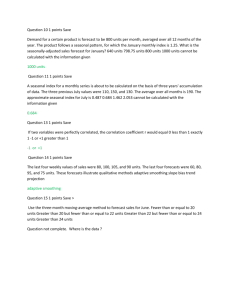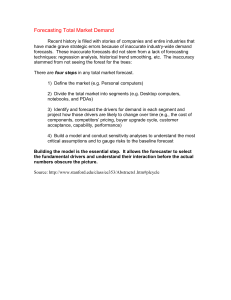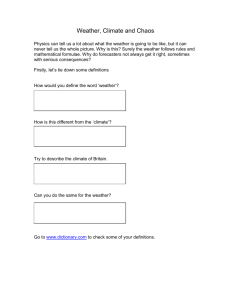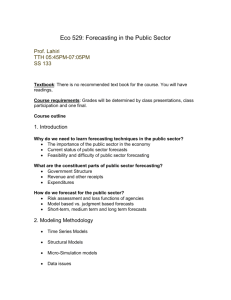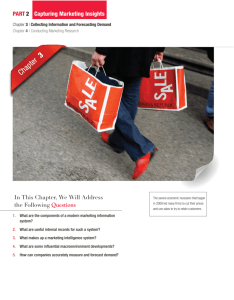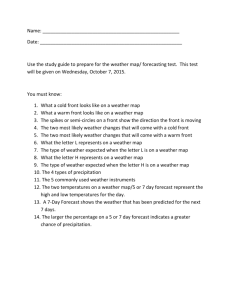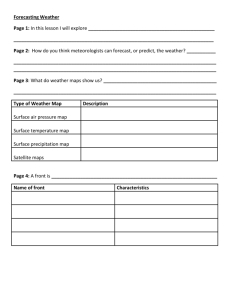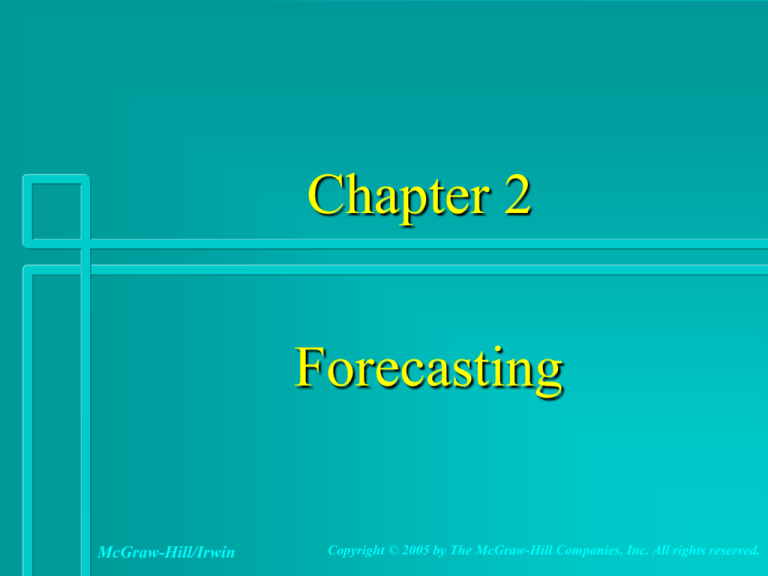
Chapter 2
Forecasting
McGraw-Hill/Irwin
Copyright © 2005 by The McGraw-Hill Companies, Inc. All rights reserved.
1-2
Introduction to Forecasting
What is forecasting?
– Primary Function is to Predict the Future
Why are we interested?
– Affects the decisions we make today
Examples: who uses forecasting in their
jobs?
– forecast demand for products and services
– forecast availability of manpower
– forecast inventory and materiel needs daily
1-3
Characteristics of Forecasts
They are usually wrong!
A good forecast is more than a single number
– mean and standard deviation
– range (high and low)
Aggregate forecasts are usually more accurate
Accuracy erodes as we go further into the future.
Forecasts should not be used to the exclusion of
known information
1-4
What Makes a Good Forecast
It should be timely
It should be as accurate as possible
It should be reliable
It should be in meaningful units
It should be presented in writing
The method should be easy to use and understand
in most cases.
– Ease of updating as new data becomes available.
1-5
Forecast Horizons in Operation Planning
Figure 2.1
1-6
Forecasting Methods
Subjective Forecasting Methods
– Measures individual or group opinion
Objective Forecasting Methods
– Forecasts made based on past history and a
model.
– Time Series Models: use only past history.
» Easy to incorporate into computer models.
– Regression: Causal Model to predict
1-7
Subjective Forecasting Methods
Sales Force Composites
– Aggregation of sales personnel estimates
Customer Surveys
» To understand future trends, change in customer view
Jury of Executive Opinion
» Maybe there is a new product etc.
The Delphi Method
– Individual opinions are compiled and reconsidered.
Repeat until and overall group consensus is (hopefully)
reached.
1-8
Objective Forecasting Methods
Two primary methods: causal models and time
series methods
Causal Models
Let Y be the quantity to be forecasted and (X1, X2, . . . , Xn)
be n variables that have predictive power for Y.
A causal model is Y = f (X1, X2, . . . , Xn).
“Y depends on X1, X2, . . . , Xn”
A typical relationship is a linear one. That is,
Y = a0 + a1X1 + . . . + an Xn.
1-9
Time Series Methods
A time series is just collection of past values of the
variable being predicted. Also known as naïve
methods. Goal is to isolate patterns in past data.
(See Figures on following pages)
Trend
Seasonality
Cycles
Randomness
1-10
1-11
Notation Conventions
Let D1, D2, . . . Dn, . . . be the past values of the
series to be predicted (demand). If we are making
a forecast in period t, assume we have observed Dt
, Dt-1 etc.
Let Ft, t + t = forecast made in period t for the demand
in period t + t where t = 1, 2, 3, …
Then Ft -1, t is the forecast made in t-1 for t and
t+1 is the forecast made in t for t+1. (one step
ahead) Use shorthand notation Ft = Ft - 1, t .
Ft,
1-12
Evaluation of Forecasts
The forecast error in period t, et, is the difference between
the forecast for demand in period t and the actual value of
demand in t.
For a multiple step ahead forecast: et = Ft - t, t - Dt.
For one step ahead forecast: et = Ft - Dt.
e1, e2, .. , en forecast errors over n periods
MAD = (1/n) S | e i |
Mean Absolute
Deviation
MAPE = [(1/n) S | e i /Di| ]*100
MSE = (1/n) S ei 2
Mean Square Error
Mean Absolute
Percentage Error
1-13
Biases in Forecasts
A bias occurs when the average value of a
forecast error tends to be positive or
negative (ie, deviation from truth).
Mathematically an unbiased forecast is one
in which E (e i ) = 0. See Figure 2.3 (next
slide).
S ei= 0
Forecast Errors Over Time
Figure 2.3
1-14
1-15
Ex. 2.1
week F1
D1
| E1 |
|E1/D1|
F2
D2
| E2 |
|E2/D2|
1
92
88
4
0.0455
96
91
5
0.0549
2
87
88
1
0.0114
89
89
0
0.0000
3
95
97
2
0.0206
92
90
2
0.0222
4
90
83
7
0.0843
93
90
3
0.0333
5
88
91
3
0.0330
90
86
4
0.0465
6
93
93
0
0.0000
85
89
4
0.0449
1-16
Evaluating Forecasts
MAD1 = 17/6 = 2.83
MAD2 = 18/6 = 3.00
MSE1 = 79/6 = 13.17
MSE2 = 70/6 = 11.67
MAPE1 = 0.0325
MAPE2 = 0.0333
No one measure can be true by itself!
better
better
better
1-17
Forecasting for Stationary Series
A stationary time series has the form:
Dt = m + e t where m is a constant (mean of
the series) and e t is a random variable with
mean 0 and var s2 .
Two common methods for forecasting
stationary series are moving averages and
exponential smoothing.
1-18
Moving Averages
In words: the arithmetic average of the N most recent
observations. For a one-step-ahead forecast:
Ft = (1/N) (Dt - 1 + Dt - 2 + . . . + Dt - N )
Here N is the parameter, that is how many past
periods are we averaging over.
What is the effect of choosing different N?
Moving Average Lags a Trend
Figure 2.4
1-19
1-20
Summary of Moving Averages
Advantages of Moving Average Method
– Easily understood
– Easily computed
– Provides stable forecasts
Disadvantages of Moving Average Method
– Requires saving all past N data points
– Lags behind a trend
– Ignores complex relationships in data
Simple Moving Average Example
Consider the following
data,
Starting from 4th period
one can start forecasting
by using MA3. Same is
true for MA5 after the 6th
period.
Actual versus
predicted(forecasted)
graphs are as follows;
Period
1
2
3
4
5
6
7
8
9
10
11
12
Actual
1-21
MA3
42
40
43
40
41
39
46
44
45
38
40
MA5
41.7
41.0
41.3
40.0
42.0
43.0
45.0
42.3
41.0
41.2
40.6
41.8
42
43
42.4
42.6
Simple Moving Average Example
1-22
Actual
MA5
47
45
43
41
39
37
MA3
35
1
2
3
4
5
6
7
8
9
10
11 12
1-23
Exponential Smoothing Method
A type of weighted moving average that applies
declining weights to past data.
1. New Forecast = a (most recent observation)
+ (1 - a) (last forecast)
or
2. New Forecast = last forecast
a (last forecast error)
where 0 < a < 1 and generally is small for stability
of forecasts ( around .1 to .2)
1-24
Exponential Smoothing (cont.)
In symbols:
Ft+1 = a Dt + (1 - a ) Ft
= a Dt + (1 - a ) (a Dt-1 + (1 - a ) Ft-1)
= a Dt + (1 - a )(a )Dt-1 + (1 - a)2 (a )Dt - 2 + . . .
Hence the method applies a set of exponentially
declining weights to past data. It is easy to show that
the sum of the weights is exactly one.
(Or
Ft + 1 = Ft - a (Ft - Dt)
)
1-25
Weights in Exponential Smoothing
For alpha = 0.1
Fig. 2-5
1-26
Comparison of ES and MA
Similarities
–
–
–
–
Both methods are appropriate for stationary series
Both methods depend on a single parameter
Both methods lag behind a trend
One can achieve the same distribution of forecast error
by setting a = 2/ ( N + 1). (How so ?)
Differences
– ES carries all past history. MA eliminates “bad” data
after N periods
– MA requires all N past data points while ES only
requires last forecast and last observation.
1-27
Exponential Smoothing for different values of alpha
So what happens when alpha is changed?
1-28
Example of Exponential Smoothing
1
2
3
4
5
6
7
8
9
Alpha = 0.4 Error
Alpha = 0.1 Error
Actual
Period
42
40
43
40
41
39
46
44
45
42
41.8
41.92
41.73
41.66
41.39
41.85
42.07
-2.00
1.20
-1.92
-0.73
-2.66
4.61
2.15
2.93
42
41.2
41.92
41.15
41.09
40.25
42.55
43.13
-2
1.8
-1.92
-0.15
-2.09
5.75
1.45
1.87
1-29
Picking a Smoothing Constant
Actual
Demand
50
a = .1
45
40
a = .4
35
1
2
3
4
5
6
7
8
9
10 11 12
Period
Lower values of a are preferred when the underlying trend is stable and
higher values of a are preferred when it is susceptible to change. Note
that if a is low your next forecast highly depends on your previous
ones and feedback is less effective.
1-30
Using Regression for Times Series Forecasting
Regression
Methods Can be Used When Trend is Present.
–Model:
Dt = a + bt.
If
t is scaled to 1, 2, 3, . . . , then the least squares estimates for a
and b can be computed as follows:
A little bit calculus, take the partial
derivatives and set it equal to 0 and
solve for a and b!
Set Sxx = n2 (n+1)(2n+1)/6 - [n(n+1)/2]2
Set Sxy = n S i Di - [n(n + 1)/2] S Di
–Let
b = Sxy / Sxx
and a = D - b (n+1)/2
These values of a and b provide the “best” fit of the data in a
least squares sense.
An Example
of a Regression Line
1-31
1-32
Other Methods When Trend is Present
Double exponential smoothing, of which Holt’s
method is only one example, can also be used to
forecast when there is a linear trend present in
the data. The method requires separate
smoothing constants for slope and intercept.
Composed of 2 separate exponential smoothing
equations; one for the average, one for the slope
of the trend.
Holt’s Double Exponential
Smoothing
1-33
St=αDt + (1- α)(St-1 + Gt-1)
– New value of intercept at time t calculated as a
weighted avg. between last demand observation and
last demand forecast
Gt=β(St – St-1) + (1- β)Gt-1
– Value of slope at time t is calculated as a weighted
average of last slope observation and last slope forecast
– τ step ahead forecast is then Ft, t+τ= St + τ Gt
1-34
Forecasting For Seasonal Series
Seasonality corresponds to a pattern in the data that repeats at
regular intervals. (See figure next slide)
Multiplicative seasonal factors: c1 , c2 , . . . , cN where i = 1 is
first period of season, i = 2 is second period of the season,
etc..
S ci = N.
ci = 1.25 implies 25% higher than the baseline on avg.
ci = 0.75 implies 25% lower than the baseline on avg.
A Seasonal Demand Series
Quick and Dirty Method of Estimating
Seasonal Factors
Compute the sample mean of the entire data set
(should be at least several seasons of data).
Divide each observation by the sample mean.
(This gives a factor for each observation.)
Average the factors for like periods in a season.
The resulting N numbers will exactly add
to N and correspond to the N seasonal
factors.
1-36
1-37
Deseasonalizing a Series
To remove seasonality from a series, simply
divide each observation in the series by the
appropriate seasonal factor. The resulting
series will have no seasonality and may then
be predicted using an appropriate method.
Once a forecast is made on the
deseasonalized series, one then multiplies
that forecast by the appropriate seasonal
factor to obtain a forecast for the original
series.
Seasonal series with
increasing trend Fig 2-10
1-38
Winter’s Method for Seasonal
Problems
A triple exponential smoothing
–
–
–
–
3 exponential smoothing equations
For the base signal (intercept) or the series, α
For the trend, β
For the seasonal series, γ
St = α(Dt/ct-N) + (1- α)(St-1+Gt-1)
Gt = β[St-St-1] + (1- β)Gt-1
ct = γ(Dt/St) + (1- γ)ct-N
1-39
Initialization
for Winters’s Method
1-40
1-41
Practical Considerations
Overly sophisticated forecasting methods can be
problematic, especially for long term forecasting.
(Refer to Figure on the next slide.)
Tracking signals may be useful for indicating forecast
bias.
Box-Jenkins methods require substantial data history,
use the correlation structure of the data, and can
provide significantly improved forecasts under some
circumstances.
The Difficulty with
Long-Term Forecasts
Tracking the Mean When
Lost Sales are Present
Fig. 2-13
1-43
Tracking the Standard Deviation
When Lost Sales are Present Fig. 2-14
1-44
1-45
Case Study: Sport Obermeyer Saves Money
Using Sophisticated Forecasting Methods
Problem: Company had to commit at least half of production
based on forecasts, which were often very wrong. Standard
jury of executive opinion method of forecasting was
replaced by a type of Delphi Method which could itself
predict forecast accuracy by the dispersion in the forecasts
received. Firm could commit early to items that had
forecasts more likely to be accurate and hold off on items in
which forecasts were probably off. Use of early information
from retailers improved forecasting on difficult items.
Consensus forecasting in this case was not the best method.

